The Story Box: Franz Boas, George Hunt
and the Making of Anthropology
and the Making of Anthropology
An exhibition developed by Bard Graduate Center and U’mista Cultural Centre
“It is good that you should have a box in which your laws and stories are kept.
“La̱’mas ik laḵus ax̱nugwada sa gix̱at’si k̕awat̕si git’sola x̱a ’ni’nuyam dłuwida ’na̱ga̱łta̱wesu g̱wayi’yelasa.
My friend, George Hunt, will show you a box in which some of your stories will be kept.
La’misa̱n ’na̱mukwex̱, George Hunt, ’niłidamas tła x̱ux̱da k̕awat̕si yex̱ git’sola tła̱x̱ x̱us ’ninuya̱mex̱.
It is a book I have written on what I saw and heard when I was with you two years ago.
Yua̱m bukw x̱a̱la su, git’sola x̱a̱n k’ada̱dza̱we su lax̱a̱n dug̱wana̱m dłuwa̱n wa̱dłana̱m lega̱n bagwa̱ns suł mała̱n xila xide.
It is a good book, for in it are your laws and your stories. Now they will not be forgotten.”
Ikux̱ bukwa, la̱max̱s git’sola x̱us ’na̱g̱a̱łta̱we su tłex̱ dła̱ wus ni’nuya̱mex̱. La̱max̱s kis tła̱liwe suł.”
—Franz Boas, in a letter to Kwagu’ł Chiefs, 14 April 1897 (translated into Kwak̓wala by Chief William T. Cranmer)
In 1897, anthropologist Franz Boas published The Social Organization and the Secret Societies of the Kwakiutl Indians. One of the first holistic portraits of a Native North American society, the book is the result of Boas’s fieldwork among the Kwakwaka’wakw of British Columbia and a deep collaboration with his Indigenous research partner, George Hunt. It features ceremonial objects from multiple museums; narratives and songs recorded in the Kwak̓wala language; eyewitness accounts of ritual; and photographs of people, villages, and artworks. Drawing on a Kwakwaka’wakw metaphor, Boas imagined his book as a storage box for “laws and stories,” preserving them for science in case the culture vanished under colonial impact.
In fact, the book fails to address three important aspects of its making: Canada’s assimilation policy, which outlawed potlatch ceremonies; the 1893 Chicago World’s Fair, where Boas and Hunt conducted much of their fieldwork; and Hunt’s proper status as a full co-author. In the early 1920s, Hunt took it upon himself to correct and expand the book, in part by reconnecting hereditary treasures to the families they belong to. Hundreds of pages of unpublished revisions were consigned to archives after Boas’s death.
This exhibition website explores the hidden histories and multiple legacies of the groundbreaking volume, which had considerable influence on anthropology, museums, and the modern concept of “culture.” It is part of an international project to create a new Critical Edition, in both print and digital media, that reassembles widely distributed materials. After a century of resilience, the Kwakwaka’wakw are reactivating these texts, museum collections, and archival records as tools for strengthening cultural identity.


